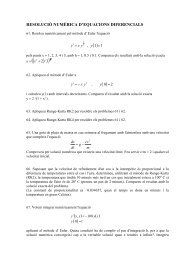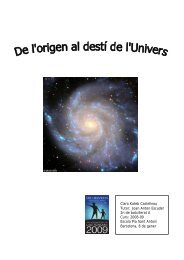Universitat de - Departament d'Astronomia i Meteorologia ...
Universitat de - Departament d'Astronomia i Meteorologia ...
Universitat de - Departament d'Astronomia i Meteorologia ...
You also want an ePaper? Increase the reach of your titles
YUMPU automatically turns print PDFs into web optimized ePapers that Google loves.
80 Chapter 2. Multiwavelength approach to LS 5039<br />
As we have already discussed, the radio emission originates as synchrotron ra-<br />
diation in a jet-like flow in the presence of a magnetic field. The near infrared and<br />
optical light arises from the high mass companion star. The X-rays probably arise<br />
in the accretion disk around the compact object. Finally, the γ-rays are probably<br />
produced by inverse Compton scattering of the ultraviolet photons of the companion<br />
star by the relativistic electrons present in the jet flow, as we discuss below.<br />
2.8.2 A mo<strong>de</strong>l based on the γ-ray/radio emission<br />
The movement of matter in the system is proposed to be as follows. The early type<br />
O6.5V((f)) star LS 5039 has a strong wind that accounts for a mass loss rate of<br />
∼ 10 −6 M⊙ yr −1 , according to McSwain & Gies (2002). While leaving the star,<br />
part of this matter will be captured by the intense gravitational field of the nearby<br />
compact object (probably a neutron star). The matter will then fall into the compact<br />
object and form a disk around it, which by viscous heating will emit in X-rays. Part<br />
of the X-ray emission can also be produced in a corona above the disk. A fraction<br />
of the matter forming the disk will be ejected perpendicular to it and in opposite<br />
senses, probably as a result of the Blandford & Payne (1982) mechanism, as seems to<br />
be the case in the quasar M87 (Junor et al. 1999). While flowing away into opposite<br />
jets, the relativistic electrons (matter) will be unavoidably exposed to a huge output<br />
of ultraviolet (UV) photons from the hot optical star. As a consequence, the UV<br />
photons will experience inverse Compton scattering, and γ-rays will be naturally<br />
produced, as <strong>de</strong>tected by EGRET. Later on, the relativistic electrons will produce<br />
synchrotron radio emission. This scenario is schematically reproduced in Fig. 2.23.<br />
It is interesting to use the presence of 5 GHz synchrotron emitting particles far<br />
away from the compact object, ∼ 1000 AU as seen in Sect. 2.4.5, in or<strong>de</strong>r to constrain<br />
the jet physical parameters. The starting point of the following calculations will be<br />
the scenario for the proposed EGRET emission of LS 5039 due to IC scattering. We<br />
recall that the energy shift in the IC process may be as high as Eγ ∼ 4γ 2 e EUV, where<br />
the energies of the γ-ray and the stellar UV photon are related through the squared<br />
Lorentz factor of the relativistic electron.<br />
We will adopt here a very simple mo<strong>de</strong>l of an expanding jet. Cylindrical coor-<br />
dinates, z and r measured parallel and perpendicular to the jet axis, are the best<br />
choice in our case. The jet is assumed to form at a distance z0 from the compact






